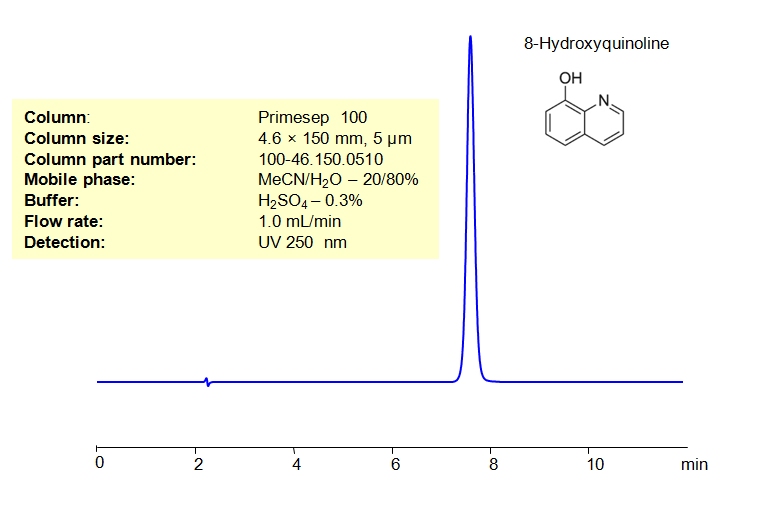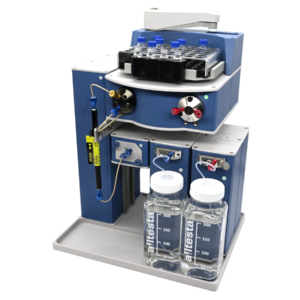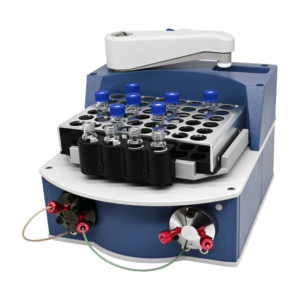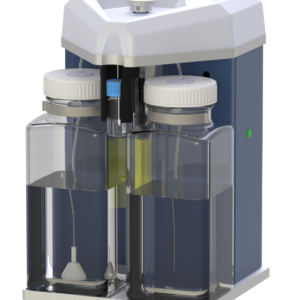HPLC Method for 8-Hydroxyquinoline on Primesep 100 by SIELC Technologies
 High Performance Liquid Chromatography (HPLC) Method for Analysis of 8-hydroxyquinoline with Primesep 100
8-Hydroxyquinoline, or oxine, is a common chelating agent that also serves as an effective antiseptic and antifungal compound. Since it is an effective chelating agent, it is often used in LC applications to determine metal contamination in silica-based columns. Even small amounts of metal ions on the silica surface can cause significant peak distortion with very low peak efficiency and poor peak symmetry.
8-Hydroxyquinoline can be retained and analyzed on either a Primesep 100 mixed-mode column using an isocratic analytical method with a simple mobile phase of water, Acetonitrile (MeCN), and a Sulfuric acid (H2SO4) buffer. Compared to a standard C19 column, Primesep 100 offers significantly better retention characteristics due to the ionic interaction of basic quinoline molecules with the cation-exchange functional groups of the column’s stationary phase.
This analytical method can be adapted to a Primesep 200 mixed-mode column by replacing the H2SO4 buffer with Phosphoric acid (H3PO4). The analytical method on either column can be UV detected at 200 nm with high resolution and peak symmetry.
For LC-MS applications, the H3PO4 can be substituted with Ammonium Formate (AmFm) with similar results on a Primesep 200 column.
High Performance Liquid Chromatography (HPLC) Method for Analysis of 8-hydroxyquinoline with Primesep 100
8-Hydroxyquinoline, or oxine, is a common chelating agent that also serves as an effective antiseptic and antifungal compound. Since it is an effective chelating agent, it is often used in LC applications to determine metal contamination in silica-based columns. Even small amounts of metal ions on the silica surface can cause significant peak distortion with very low peak efficiency and poor peak symmetry.
8-Hydroxyquinoline can be retained and analyzed on either a Primesep 100 mixed-mode column using an isocratic analytical method with a simple mobile phase of water, Acetonitrile (MeCN), and a Sulfuric acid (H2SO4) buffer. Compared to a standard C19 column, Primesep 100 offers significantly better retention characteristics due to the ionic interaction of basic quinoline molecules with the cation-exchange functional groups of the column’s stationary phase.
This analytical method can be adapted to a Primesep 200 mixed-mode column by replacing the H2SO4 buffer with Phosphoric acid (H3PO4). The analytical method on either column can be UV detected at 200 nm with high resolution and peak symmetry.
For LC-MS applications, the H3PO4 can be substituted with Ammonium Formate (AmFm) with similar results on a Primesep 200 column.
| Column | Primesep 100, 4.6 x 150 mm, 5 µm, 100 A, dual ended |
| Mobile Phase | MeCN – 20% |
| Buffer | H2SO4 – 0.3% |
| Flow Rate | 1.0ml/min |
| Detection | UV, 250 nm |
| Class of Compounds | Antiseptic |
| Analyzing Compounds | 8-Hydroxyquinoline |
Application Column
Primesep 100
Column Diameter: 4.6 mm
Column Length: 150 mm
Particle Size: 5 µm
Pore Size: 100 A
Column options: dual ended
Application Analytes:
8-HydroxyquinolineApplication Detection:
UV Detection
SIELC Technologies usually develops more than one method for each compound. Therefore, this particular method may not be the best available method from our portfolio for your specific application. Before you decide to implement this method in your research, please send us an email to research@sielc.com so we can ensure you get optimal results for your compound/s of interest.




